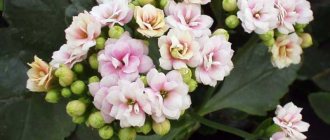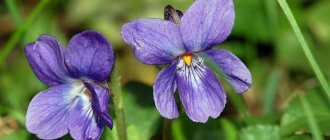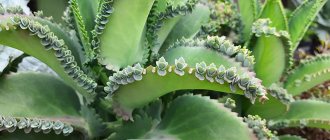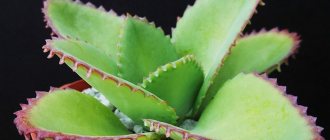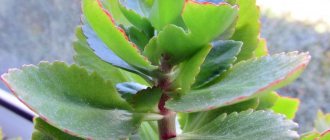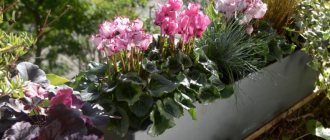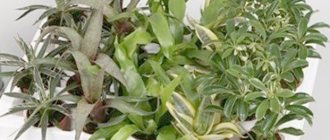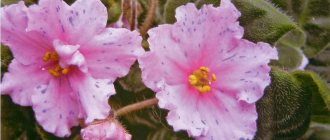Kalanchoe is a fairly common houseplant. There are various types of it: succulent plants, herbaceous perennials, subshrubs. Today, there are about 200 species of Kalanchoe around the world. This genus belongs to the Crassulaceae family. In nature, it can be found in Asia, Australia and America. We usually grow it at home. Let's learn in detail about how to organize proper care at home for Kalanchoe Mix and its various varieties.
Short description
You may be interested in: Growing bamboo in water at home, care, reproduction, diseases
Types of Kalanchoe do not differ too much from each other in appearance and care. The main difference lies in the shape of the leaves, which, depending on the variety, can be thick, dissected, sessile, or located on the petiole. In this article we look at varieties of Kalanchoe Mix, home care and cultivation features.
As already mentioned, Kalanchoe Mix has several subspecies that differ in external characteristics. The most common is Mini Mix, or Blossfeld variety. This is a fairly compact plant that fits perfectly on a windowsill. It is distinguished by a lush flowering crown. Flowers have a variety of shades: red, white, lilac, pink. It is also worth noting Kalanchoe Kalandiva mix; caring for it at home is very simple, so many choose this particular variety not only because of its ease of cultivation, but also for its fascinating flowering. Kalandiva has large fleshy velvety leaves, a rather thick stem and small double flowers that form lush red, pink or yellow blooms. It is impossible not to mention Kalanchoe Rosalina mix; caring for this species at home also does not cause much trouble. From the name itself it is clear that Rosalina has pink flowers and is also famous for its healing properties.
Botanical description
Kalanchoe is a genus of leafy succulents consisting of 200 perennial species. Belongs to the Crassulaceae family.
The area is quite extensive:
- South America;
- Africa;
- Madagascar island;
- south of Asia.
Among those capable of beautifully blooming, upright ones are Kalanchoe Fedchenko, Blossfeld and its hybrids. Mangina is a typical ampel.
Stems for all types:
- juicy;
- fragile;
- herbaceous;
- For good branching they require pinching.
The shape and size of the leaves depend on the species. But the plates of Kalanchoe in nature are designed to store moisture reserves, which are consumed during the dry period, in the taxa listed above:
- thick;
- fleshy;
- juicy;
- with a shiny, smooth epidermis that does not allow moisture to be lost under exposure to sunlight or in the heat.
Lighting
You may be interested in: Coin tree: care and maintenance at home, medicinal properties
If you grow Kalanchoe at home, then first of all you should pay attention to lighting. For this flower, daylight hours must last at least twelve hours. That is why, from spring to autumn, the pot with the plant should be placed on a window that faces the east or west side. In winter, it is better to move it to the south side. If you live in a region where daylight hours in winter are too short, you will need to take care of artificial lighting.
What to do during flowering
Caring for Kalanchoe mix varieties during the flowering period often includes the use of light. Thus, with the help of artificial lighting, experienced gardeners obtain a luxurious flowering plant that pleases the eye once a year - from the beginning of February to the end of March. Preparations for the next flowering season begin after the end of the current one. Care involves removing excess shoots and old peduncles. Timely pinching off of the upper leaves on grown shoots is carried out. The procedure is carried out again when 3 pairs of leaves are visible on the young shoots. This is how a lush bush is formed.
Shortly before flowering begins, pinching is done for the last time. Experts say that with good care the plant can bloom twice a year. If during the flowering period there is a cessation of flowering, it is necessary to give the crop “shock therapy” at home. It is covered with dense material and placed in a dark place, excluding watering for 3 weeks. When returning your pet to its original place, do not forget to apply fertilizer. If the plant does not begin to bloom by mid-March, the cause may be mold, insects or fungal infections.
Temperature
You may be interested in:Venus flytrap: how to care for the plant at home
Kalanchoe is not one of the capricious plants and feels absolutely normal at any temperature in the room. But this does not mean that you can put it on the balcony in winter. In summer, the air temperature in the room should not fall below 18 degrees and rise above +28 °C. In winter, the flower can easily tolerate a drop in temperature to +14 °C. It is worth considering that if the air temperature in the room is below ten degrees with a plus sign, then there is a high probability that the plant will become very sick, and perhaps even die. Also note that at low temperatures, buds begin to appear on the plant.
How to water Kalanchoe Mix
Kalanchoe Mix at home should be watered only with soft, settled water at room temperature. There is no need to overwater the plant, as rotting may begin. It is recommended to moisten the soil only when the top layer is completely dry. Moreover, Kalanchoe is a crassula plant, which means that its fleshy leaves always contain a small supply of water. But at the same time, the situation cannot be brought to the point where the earthen ball dries out completely. This situation often leads to the leaves starting to fall off the plant. In winter, the watering technology is that the substrate is moistened three or four days after it dries out. You can water the plant at the root, or you can simply pour water into the pan. Then the Kalanchoe will be able to “drink” as much water as it needs.
Description of the plant
Kalanchoe belongs to the group of succulents. The flower does not grow in the wild, as it was bred by breeders. Other types of plants can be seen in nature on almost all continents of the globe.
Kalandiva is a particularly decorative flower, which is noted for its long and abundant flowering. This is a compact bush that has fairly thick stems. The flower is characterized by the presence of neat fleshy leaves, which are not deprived of smoothness or velvety. The height of the bush does not exceed 30 cm.
The plant is distinguished by the presence of short peduncles on which inflorescences of small double flowers are located. They are distinguished by a variety of colors.
The flowers of the plant can be pink, red, salmon, yellow.
Flowering Kalanchoe is a short-day crop. The plant will bloom only if the light regime is strictly observed. The culture is characterized by abundant flowering, which can be observed for 6 months. In most cases, Kalanchoe blooms in mid-winter.
Important! From mid-summer, a dormant period begins, which is characterized by mild expression. That is why Kalanchoe kalandiva does not need special care at this time.
Kalanchoe calandiva is a rather attractive flower that can decorate the design of any room with original blooms.
Spraying
In general, there is no need to spray Kalanchoe, since the plant feels quite normal without it. However, in hot summer weather this procedure can be performed. This will only make the plant better. The need for spraying is explained by the fact that this flower has fleshy, sometimes pubescent, leaves from which moisture evaporates rather slowly.
Is pruning necessary?
You may be interested in: Why do orchid flowers wither? How often to water an orchid at home? Orchid care after flowering
It is worth pruning for Kalanchoe, since many of its species shed their leaves and the stems remain “bare”. It is these shoots that can be cut off and replanted in a new container or next to an old plant. There are types where the shoots fall over the edge of the pot. They can also be trimmed and replanted, or left hanging. It all depends on your imagination and desire.
Kalanchoe Mini Mix: appearance, main characteristics
Obtained as a result of mixing several varieties of Kalanchoe, the Mix belongs to the Tolstyankov family. In a favorable environment, a home specimen can grow up to 40 cm. However, most gardeners try to grow a more compact bush, so they regularly trim and pinch it. Thanks to such actions, the plant abundantly grows foliage and blooms.
Kalanchoe Mini Mix
Kalanchoe grown at home has rather fleshy leaves and stems that have the ability to accumulate moisture. Very often the leaves grow up to 5 cm in length and 3 cm in width. They have a standard ovoid shape, and their edges have slightly rounded teeth.
For your information! The leaves of Kalanchoe Mix have a dark green color, and with proper care they have a glossy shine.
During the growing season, buds appear at the tops of the bush, forming into racemose inflorescences. Blooming flowers reach 1 cm in diameter and are terry to the touch. Their colors can be pink, white, red, purple or orange.
Features of flowering
The article has already mentioned that daylight hours for Kalanchoe should last at least twelve hours. The flowering of the plant depends on this. Also note that the lighting must be bright. An interesting fact is that some flowers on the plant fade very quickly, but if you cut them and put them in a vase, they can last about three weeks. When flowering stops, a certain part of the stems must be cut off to give the plant a beautiful appearance. The cut shoots can be thrown away, but if you want to have as many of these plants in your home as possible, then use them as cuttings.
How to care for Kalanchoe Kalandiva mix
With proper care, the flowering of Kalanchoe Kalandiva, starting in the winter months with short daylight hours, will last until mid-summer. The regime of watering and fertilizing at this time and during the resting period of the flower is different. For lush flowering next year, the plant needs quality rest.
Watering requirement
Kalanchoe is a succulent, and therefore tolerates drought more easily than overwatering. Moisten the soil moderately: in summer - after the top layer of soil has dried, in winter - when the earthen ball dries out by 2/3. During the months of active growing season, one watering every few days is usually sufficient; during the dormant period (from early September to January) - two or more times less often.
A few minutes after watering, the water accumulated in the pan is removed. The procedure is repeated several times within an hour (experienced gardeners even end up wiping dry both the tray and the bottom of the pot). Overwatering a succulent can lead to the development of root rot.
Feeding
Kalandiva needs to be fed with fertilizers when setting buds. As a rule, this is the end of summer and the beginning of autumn. As a top dressing, it is most useful to use ready-made mixtures intended for succulents. Organic matter is not used, since excessive nitrogen content has a detrimental effect on the condition of the roots, provoking rotting, and in addition, it is also the reason for the fattening of the bush, when all its strength is spent on growing leaves and shoots, and there is no strength left for flowering.
The fertilizer mixture is dissolved in water for irrigation.
Plant Formation
Pruning Kalanchoe Kalandiva mix is practiced:
- for decorative purposes - to give the flower a more harmonious, neat appearance;
- for its rejuvenation - at the root;
- to prepare for flowering next year (since inflorescences form only at the ends of young apical stems);
- after flowering to remove faded flower stalks.
During the flowering period, Kalandiva is not disturbed by pruning, but during the rest of the growing season, the branches are pinched or cut from the top to a distance of two leaves - this is done until the bush acquires the desired shape.
After wilting, the flower stalks are removed so that they do not spoil the “elegant” appearance.
A sharp knife, regular or stationery, is suitable as a tool. If it has already been used to trim other plants, you need to disinfect the blade with alcohol. It is not recommended to break off shoots or tops.
It is worth paying attention to the fact that no more than a quarter of the total volume of greenery can be removed at a time
Pests and diseases
Kalanchoe Kalandiva is a plant with high immunity; it gets sick or is attacked by pests extremely rarely - only when the rules of caring for it are chronically violated. If a pest attack does occur, it is usually aphids or scale insects:
- aphids usually move to Kalanchoe from other plants (sometimes they are already sold infected). The pest sucks juices from the pulp of leaves and stems, while simultaneously blocking the pores with the products of its vital activity. To destroy the parasite, insecticides are used, which are used to treat both the bush itself and the soil;
- Scale insects are also attracted to the lush greenery of Kalanchoe. Since a wax shell protects insects from chemical exposure, they are first removed mechanically - with cotton wool soaked in alcohol. And after that, they treat it with an insecticide and replace the soil in the pot with fresh, uninfected one.
Overwatering combined with cool temperatures or drafts can cause gray mold or powdery mildew to develop. A sign of the first disease is weeping spots with a dark coating on the leaves and stems. Powdery mildew, as the name implies, appears as a flour-like, slightly sticky coating on the trunk and foliage. In both cases, for treatment, both the flower and the soil are treated with fungicides.
Please note: immediately after acquisition, the plant is left alone for a week-long adaptation period. At this time, carefully monitor its condition: is there any yellowing or browning of the leaves, or their curling?
All these are signs of existing diseases or parasite damage. In such a situation, you cannot place the flower with other plants.
Transfer
When talking about how to provide care for Kalanchoe Mini Mix at home, we cannot fail to mention replanting. This type of plant is replanted quite rarely. This is only necessary if the flower grows greatly and no longer fits in the pot. The bottom of a new pot must be lined with expanded clay or broken bricks. This is very good drainage and will remove all excess liquid from the container. For young specimens, it is recommended to use a special substrate, which should include: four parts of turf soil, two parts of deciduous soil and one part each of peat and sand. If you don’t want to spend time preparing a homemade substrate, you can simply purchase soil for succulent plants at a special store. It is worth noting that epiphytic Kalanchoes love it when the substrate contains a small proportion of humus. All other types do not require this. The same applies to organizing home care for Kalanchoe Kalandiva Mix and its other varieties.
How to care at home
Although caring for Kalanchoe mini mix is simple, some rules must still be followed. By choosing the right lighting, temperature, watering, humidity and periodically feeding the bush, you can achieve high-quality flowering. Also, do not forget about pruning - it helps to form a beautiful and compact crown.
Temperature and lighting
Since Kalandiva is a short-day plant, it is simply necessary to organize suitable lighting. In order for the plant to lay flower buds, light must fall on it for only 8-10 hours. This is easy to achieve - just cover the succulent with a paper cap, take it to a darkened room or put it in a closet.
Place a pot of mini Kalanchoe on a windowsill with intense light. Southern and eastern windows are suitable, but during the peak of the heat, do not forget to shade the bush from direct sunlight. Otherwise, burns in the form of brown and yellow spots will appear on the leaves, which will significantly spoil the decorative appearance of the flower.
In winter, when daylight hours are too short, with proper care, additional artificial lighting is provided. You can use both phytolamps and LED or fluorescent lamps (glow temperature - 6500 K).
Insufficient lighting manifests itself in the form of elongated shoots of Kalanchoe, shrinking leaves, as well as deterioration or cessation of flowering. In this case, move the pot closer to the light source.
In the summer season, the maximum permissible temperature for keeping Kalanchoe mix is considered to be +27-28 degrees, but in winter the mark drops to +10-15. If you want to stimulate flowering, leave the bush in a cool room, where the temperature range ranges from +14-16 degrees - in such conditions, flower buds will form as intensively as possible.
Proximity to heating appliances, fireplaces and other heat sources has a negative impact on Kalandiva's health. The same can be said about drafts, prolonged exposure to which can cause the death of a succulent.
Watering and humidity
Kalanchoe mini does not tolerate waterlogging and flooding of the soil, so the plant is watered only as needed. To avoid basic mistakes, take into account a few tips:
- In summer, the soil must be moistened once every 5-6 days, in winter - less often, once every 10-14 days;
- Focus on the condition of the substrate and water after the top layer of soil dries;
- Excess liquid should not stagnate in the pan, so always drain the water half an hour after watering;
- Water should be used at room temperature, standing until sediment forms;
- Water along the edge of the pot to keep moisture away from parts of the plant.
Since the succulent feels comfortable in the usual humidity of city apartments, there is no need to spray it additionally. If dust or other dirt has accumulated on the leaves, wipe them with cotton wool.
Fertilizer application
Fertilizing Kalanchoe mix is not just for show - nutrients, minerals, micro- and macroelements play an important role in the development of the succulent and affect the quality of its flowering. You can use special formulations for succulents and cacti, or purchase universal fertilizers for indoor flowering plants. In the latter case, it is important to reduce the dosage of fertilizer by 2-3 times recommended on the packaging in order to eliminate the possibility of overfeeding.
When applying fertilizer, be sure to consider the time of year:
- In summer, feed once every 14 days;
- In winter - once a month.
The soil must be moist - only in this case burns will not form on the roots. To do this, use fertilizer immediately after watering or dissolve it in water.
Crown trimming
It is necessary to prune the Kalanchoe mix to preserve its decorative properties, since the shoots of this variety grow quite quickly. As a result, a situation often arises when only the tops of branches remain leafy, which does not look very aesthetically pleasing. Simple manipulations help to “keep” the succulent in a compact size:
- Elongated shoots are shortened by half their length;
- Branches that grow intensively are pruned by 1/3;
- The tops of young plants are pinched to stimulate branching;
- All excess shoots growing inside the bush are completely removed.
Don’t forget to cut off the flower stalks when the budding period is over - this is an effective prevention against fungal diseases and pests. You should only use sharp, disinfected instruments.
Reproduction
Kalanchoe reproduces quite easily. This can be done by rooting a leaf or stem. This procedure is quite simple. It is enough just to separate a shoot or leaf from the mother plant at the beginning of summer and immediately plant it in prepared nutritious soil. If you decide to choose a leaf for propagation, then it should be covered with a jar after planting to create a greenhouse effect. It does not need to be watered often, but it is better to spray it from time to time. Quite quickly the leaf should take root and begin to grow.
Features of reproduction
Kalanchoe Kalandiva reproduces in several simple ways:
- seeds;
- children;
- cuttings.
But most often, gardeners use stem cuttings, for this you will need:
- Separate the fully mature shoot from the parent plant.
- Next, root it in well-moistened sand.
- Cover the rooted cutting with a glass. This will create greenhouse conditions.
The measles system forms very quickly, and the rooting process lasts no more than 1.5 weeks. Flowering of the decorative crop occurs after planting in a permanent place six months later.
The more difficult method of propagation is leaf cuttings. To do this, cut off an adult leaf and plant it in a pot with a thoroughly moistened fertile substrate. Cover the leaf with a jar or glass. After 2-3 days it will take root and a full-fledged plant will begin to form from it. For propagation, you can use parts of the leaf blade buried in the ground. Young plants also quickly form from them.
Propagation by seeds is the most risky, since it is accompanied by the absence of varietal characteristics of the parent plant in the resulting seedlings.
Kalanchoe Kalandiva is an amazing home plant that can be grown for two purposes - decorative and medicinal. And although the flowering does not last long, it is very beautiful and fascinating. In addition, you can plant several types of Kalanchoe with different flower colors and create your own unique flower arrangement.
Propagation by seeds
In addition to cuttings, when breeding Kalanchoe Mix, home care also includes seed propagation. Sowing of seeds is carried out towards the end of winter, and preferably in early spring. To do this, take leafy soil. There is no need to deepen the seeds. It is enough just to scatter them on the surface of the substrate and lightly press them with your fingers. After this, there is no need to sprinkle soil on top. After planting, the container must be covered with a transparent film or glass to create a greenhouse effect. Ventilation is required twice a day: morning and evening. You should also control the air temperature, which should not fall below sixteen degrees and not rise above twenty. Be sure to water regularly so that the soil does not dry out. Water for irrigation should be warm and settled. With the appearance of the first sprouts, the glass can be safely removed. After three to four weeks, you can carry out the first pick. The container should be slightly larger. The seedlings dive for the second time when three or four true leaves appear on them.
There must be a drainage layer at the bottom of the pot, and four parts of peat, two parts of turf soil and one part of sand must be poured on top. When you see that your seedlings are already well rooted, you should pinch the top. This is necessary so that the branching is more magnificent. The next transplant should be carried out only after the entire pot is filled with roots. The new soil will need to consist of four parts compost, two parts humus, one part hardwood soil and one part sand. The very next year Kalanchoe will delight you with its flowering.
Kalanchoe mix: care, feeding, reproduction, transplantation and diseases
My passion for succulents began with an ordinary cactus given by colleagues for my birthday. Now, after many years, my whole house is filled with these beauties, and I have fully studied all the features of caring for them. Today I will tell you about one of the most beautiful and unpretentious representatives of succulents - Kalanchoe mix.
Kalanchoe mix plant
Kalanchoe mix looks like a small bush that reaches a height of thirty to forty centimeters. On thick, strong stems there are large green leaves with sharp edges. This plant blooms from several months to six months. Delicate fluffy flowers in a variety of shades of pink, cream, yellow and red are collected in umbels carried on short stems.
Kalanchoe mix care: humidity regime
Kalanchoe needs to be watered on average once every ten to twelve days. You can determine the need to water the plant by feeling the soil; it should be dry. It is the root zone that needs to be watered; water should not get on the leaves and stem.
It is very important to empty the water from the pan under the pot, because the roots may begin to rot.
Be careful: a large amount of moisture in the soil of Kalanchoe can be seen by the withered and drooping leaves. In this case, you need to water the plant less often.
Kalanchoe is a succulent, which means it is already adapted to lack of moisture. Therefore, there is no need to spray the plants and humidify the air. But sometimes the plant can be given a general cleaning by removing dust and dirt from the leaves.
Kalanchoe mix care: light
Kalanchoe loves plenty of light throughout the day, but during hot weather it is better to protect the leaves from burning. The best place to place the plant will be the east or west side of the house. In cold times, when there are few sunny days, the plant needs auxiliary light sources. During the whole day, the plant should be exposed to light for eleven to twelve hours throughout the year.
Kalanchoe mix care: temperature regime
In summer, it feels great even at thirty degrees Celsius. In winter, comfortable temperatures range from fourteen to eighteen degrees.
Kalanchoe mix care: feeding
Kalanchoe mix is accustomed to infertile soil. Due to its biological characteristics, the plant can easily do without feeding. But during the flowering period, it is advisable to add a small amount of special fertilizers for succulents to the water. There are no specific recommendations; any fertilizer will do.
Kalanchoe mix transplantation and propagation
This plant is not propagated by seeds. Two methods are suitable for propagating this crop: using cuttings or foliage. They need to be cut off from the parent specimen and dried for a couple of hours. After this, the leaf or cutting must be rooted in a certain medium (water or sand), then planted in a pot.
For the first few years, it is advisable to replant Kalanchoe mix annually, then it will be enough to do this once every three to four years.
It is very important to replant into a pot slightly larger than the previous one, but do not overdo it, as the plant will react to a pot that is too large with slow growth
Transfer procedure
Place a drainage layer on the bottom of the new pot. Remove the Kalanchoe from the old pot along with the old soil. If rotting or diseased roots are visible, they need to be removed. Pour soil into a new pot and cover with soil without compacting it. Water with water and fertilizer and add a little soil if it has settled too much.
Pests and diseases
Kalanchoe mix is affected by: Rot. Forms if there is poor ventilation in the room or the soil is too wet. Can be identified by the unpleasant odor and wilting of the leaves. The treatment method is fungicides and reducing watering. Powdery mildew. Looks like white spots on the plant and causes leaves to drop.
Treatment - fungicides, more frequent but less abundant watering, lowering the air temperature. Mealybug. Can be identified by white mold-like stains on the leaves. Control measures include removing diseased plant fragments, spraying with specialized preparations. Aphids and scale insects (usually come from infected plants of other species).
Visible to the naked eye, the removal method is insecticide treatment.
Medicinal properties
If you were able to provide good care at home for Kalanchoe Mix, then it will definitely become an excellent helper for you.
Kalanchoe is not only a beautiful, but also a very useful indoor plant. Kalanchoe juice is used in many areas of medicine. It is used to treat various gynecological diseases, as well as in dentistry. The juice perfectly heals various wounds and ulcers, eliminates the effects of frostbite and is especially often used to treat serious burns. It can also be useful for tonsillitis and stomatitis. Kalanchoe can safely be called a home first aid kit, since it can help out in various situations in the absence of the necessary drugs.
Diseases of Kalanchoe variety Rosalina
The beneficial properties of Kalanchoe mix grown at home include its use in the field of cosmetology - for the manufacture of creams, lotions, and tonics. In medicine, its juice is used to treat skin ailments. The plant has bactericidal properties. And this is not all the advantages of culture. Therefore, her sudden illnesses can greatly upset her owners. What kind of troubles can plague the Rosalina plant?
At home, if grown incorrectly, its leaves may fall off. The reason is a lack of important elements in the soil. If excessive doses of fertilizing are applied, the crop may not bloom, although it will look quite healthy. If the leaves change their usual color to yellow, and the lower foliage falls off, this is a signal that your pet should adjust the amount of light. It is best to provide the crop with shade. At high levels of humidity and low temperatures, ugly black spots are found on the surface of the leaves. Kalanchoe may dry out if it has not been watered for a long time, the wrong soil mixture has been selected, or it is attacked by pests.
Kalanchoe parasites include mites, aphids, scale insects, and scale insects. Insecticidal preparations are intended to combat ticks. Treatment with laundry soap will help remove aphids in the early stages. Severe damage will require pruning and insecticide treatment. Against scale insects, wiping the leaves with an alcohol solution and removing parasites with an old toothbrush is used. Any modern insecticide can easily deal with scale insects. When powdery mildew or gray mold appears, it is customary to use special preparations that are sold in flower shops.
Diseases and pests
As already mentioned, although Kalanchoe normally tolerates a decrease in temperature, still too low indicators can have a detrimental effect on the condition of the plant. If the flower is watered too much, and even at low temperatures, there is a risk that mold will appear on it. The plant may also develop powdery mildew. But this is caused by excessive watering even when the air temperature in the room is too high.
Many people worry when the stem of a Kalanchoe grows too long or becomes completely bare. This is a completely natural process that you should not be afraid of. Often such shoots are simply cut off and used as cuttings for propagation.
Brief conclusions
In the article we examined the characteristics of many varieties of plants, including Kalanchoe Blossfeld mix, home care, features of transplantation, propagation and much more. It is worth noting a few of the most important points:
- Kalanchoe needs long daylight hours (at least 12 hours);
- loves high temperatures, but tolerates low temperatures well;
- It is not recommended to water the flower too often, as there is a risk of developing various diseases;
- This plant is widely used in various areas of medicine, so having it in the house is a must.
If you organize proper care at home for Kalanchoe Mix, then it will certainly delight you with its flowering, and can also help in the treatment of various diseases.
Source
Problems during cultivation
Most often, owners complain that Kalanchoe does not want to bloom again. But sometimes they encounter other problems due to errors in care.
Doesn't bloom
Some lovers note that the hybrid Kalanchoe does not bloom for the second time in a year, or instead of an abundant thick head, rare buds appear. Or the bush refuses to bloom at all in the new season.
Causes:
- absence of a dormant period - after the loss of decorativeness, the owners immediately stimulate the plant to bloom again;
- long daylight hours;
- excessive fertilizing, excess nitrogen is especially dangerous for the crop;
- potassium deficiency;
- abundant watering;
- high temperature during the rest period;
- large pot;
- owners do not replant when Kalanchoe stops blooming;
- the plant is not pruned;
- excessively nutritious heavy soil, for example, intended for azaleas;
- pests or diseases.
Turns yellow
Kalanchoe Blossfeld, after the bush has stopped blooming, loses some of its leaves, this is normal. Sometimes they turn yellow before falling.
There is no need to worry if only the lower plates alternately change color in older specimens. This is a natural process.
Other causes of yellowing leaves:
- overflows or severe drying of the substrate;
- excess fertilizer, yellow color gradually turns brown;
- the bush is not formed, it is too thick, some plates do not receive light at all and die;
- problems with the root system;
- hot;
- unsuitable substrate;
- excessive lighting - too bright and too long;
- pests or diseases.
Kalanchoe rarely turns yellow from a lack of microelements. The plant extracts and converts many nutrients from water, soil, and air, like other succulents.
